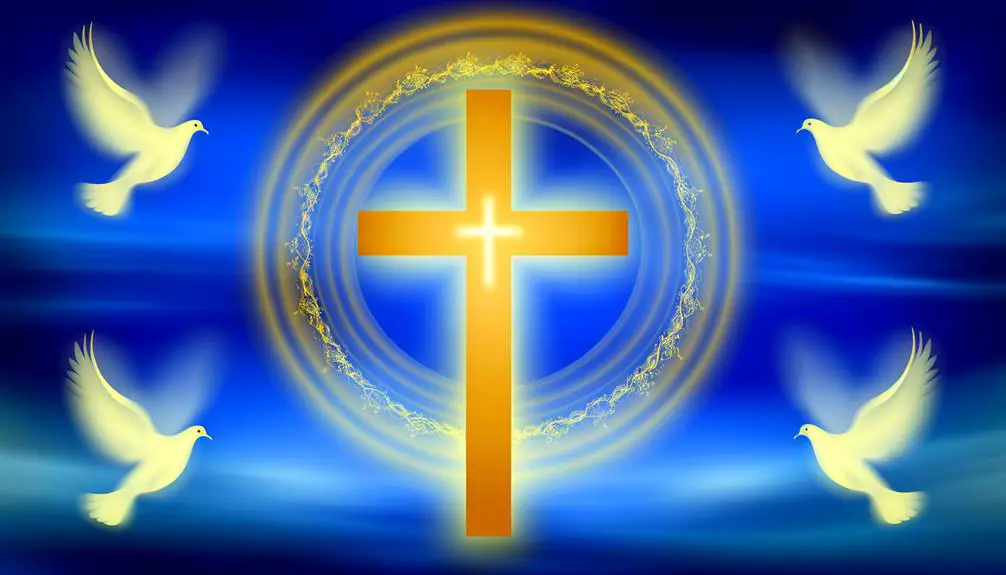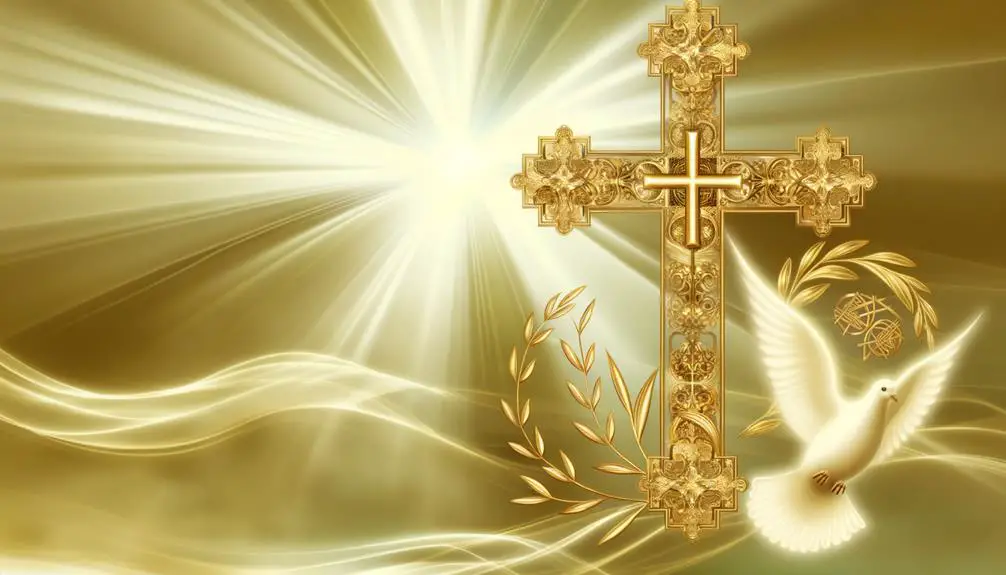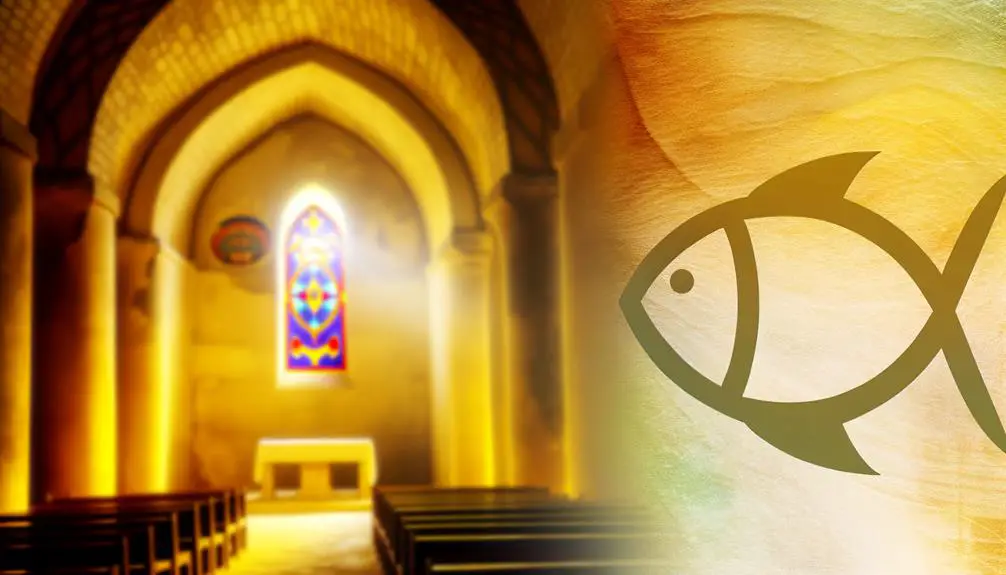What Is the Meaning of the Church of God Symbol?
The symbols of the Church of God are rich in theological and historical significance. The Cross signifies sacrificial atonement and reconciliation with God, reflecting Jesus' crucifixion.
The Dove represents divine peace and the Holy Spirit's presence, rooted in biblical narratives such as Noah's story. The Lamb signifies Jesus Christ's purity, sacrifice, and redemption.
The Crown embodies divine authority and victory over sin, promising eternal life. The Fish, or Ichthys, stands for Jesus Christ, Son of God, Savior, and underscores early Christian faith and resilience.
Moreover, Alpha and Omega highlight God's eternal and all-encompassing nature. To explore the depth of these symbols…

Key Takeaways
- The Cross symbolizes sacrificial atonement and reconciliation with God, commemorating the crucifixion of Jesus.
- The Dove represents divine peace, the Holy Spirit, and tranquility, rooted in biblical narratives like Noah's story.
- The Lamb signifies purity, sacrifice, and redemption associated with Jesus Christ's sinless nature and atonement.
- The Crown denotes Christ's kingship, victory over sin and death, and the promise of eternal life for believers.
- The Fish, or Ichthys, symbolizes Jesus Christ, Son of God, Savior, and was used by early Christians as a secret sign of faith.
The Cross

The Cross, as a central symbol within the Church of God, embodies profound theological significance and serves as a tangible representation of the sacrificial atonement central to Christian faith.
This emblem not only commemorates the crucifixion of Jesus Christ but also encapsulates the doctrines of redemption, grace, and salvation.
Theologically, the Cross signifies the intersection of divine justice and mercy, where sin is expiated through Christ's suffering and death. Its vertical and horizontal beams symbolize the reconciliation of humanity with God and the unification of believers across the world.
Historically, the Cross has been a rallying point for ecclesiastical identity, inspiring countless theological reflections, liturgical practices, and devotional life, thereby reinforcing its pivotal role in Christian spiritual heritage.
The Dove
The dove holds a significant place within the Church of God, symbolizing peace and the Holy Spirit. It embodies tranquility and divine presence, reflecting its portrayal in biblical narratives.
Symbol of Peace
As an emblem of tranquility and harmony, the dove holds profound significance within the Church of God, symbolizing divine peace and the presence of the Holy Spirit.
Historically, the dove's imagery is deeply rooted in biblical narratives, such as the story of Noah, where a dove carrying an olive branch signified the end of the flood and restoration of peace (Genesis 8:11).
This enduring symbol encapsulates the ideals of reconciliation, purity, and hope.
Within the theological framework, the dove's serene nature is often associated with the peace that surpasses all understanding, as delineated in Philippians 4:7.
Its representation extends beyond mere iconography, embodying a spiritual promise of comfort and divine serenity amid life's adversities.
Holy Spirit Representation
In Christian theology, the dove serves as a powerful and evocative symbol of the Holy Spirit, representing divine presence and guidance. This emblematic association originates from scriptural narratives, most notably during the Baptism of Jesus, where the Holy Spirit is described descending like a dove (Matthew 3:16, Mark 1:10).
The dove embodies purity, peace, and the gentle yet profound influence of the Holy Spirit upon believers. Its representation underscores the transformative and sanctifying role of the Holy Spirit within the Church. Theologically, the dove's depiction highlights the transcendence and immanence of God's spirit, offering comfort and guidance.
The dove operates as a multi-faceted symbol, enriching Christian iconography and deepening doctrinal understanding of the Holy Spirit's function.
The Lamb

Central to the symbolism of the Lamb in the Church of God is its representation of purity, sacrifice, and redemption, drawing deeply from biblical narratives and theological interpretations.
The Lamb is often associated with Jesus Christ, who is referred to as the 'Lamb of God' in the New Scripture. This symbol encapsulates the essence of Christ's sacrificial death, which is believed to atone for humanity's sins.
The Lamb's purity signifies Christ's sinless nature, while the sacrificial aspect underscores the profound theological concept of substitutionary atonement.
Redemption, embodied in the Lamb, reflects the deliverance from sin, offering believers a path to salvation. Therefore, the Lamb serves as a powerful emblem of Christ's ultimate sacrifice and the hope of eternal life.
The Crown
How does the Crown symbolize authority, victory, and eternal life within the Church of God?
The Crown represents divine authority, connoting Christ's kingship and sovereignty over all creation. Biblically, it signifies victory over sin and death, as seen in passages like 2 Timothy 4:8, where the Apostle Paul speaks of the 'crown of righteousness' awarded to the faithful.
This imagery extends to believers, who are promised a share in Christ's reign and triumph. Moreover, the Crown embodies eternal life, reflecting the promise of immortality for those who persevere in faith, as articulated in James 1:12.
The Crown serves as a multifaceted symbol encapsulating the divine authority, ultimate victory, and the promise of eternal life bestowed upon the faithful.
The Fish

The symbol of the fish, known as the Ichthys, holds significant meaning within the Church of God, tracing its origins to biblical references where Jesus called His disciples to be 'fishers of men.'
Early Christians adopted this symbol as a secret sign of identification and faith, particularly during times of persecution.
In contemporary practice, the fish continues to serve as a powerful emblem of Christian belief and unity, reflecting both historical reverence and modern spiritual identity.
Biblical Origins
Drawing from early Christian traditions, the symbol of the fish, also known as the Ichthys, has its roots deeply embedded in the New Scriptures narratives and serves as a covert sign of faith during periods of persecution. The Greek word 'Ichthys' translates to 'fish' and is an acronym for 'Jesus Christ, Son of God, Savior.' This symbol holds significant biblical references, including:
- Miracle of the Loaves and Fishes: Demonstrates Christ's divinity and providence.
- Call of the Fishermen: Symbolizes the disciples' mission to be 'fishers of men.'
- Jonah's Deliverance: Prefigures Christ's resurrection.
- Baptismal Imagery: Represents new life and initiation into the Christian faith.
These references underline the theological importance and historical context of the Ichthys.
Early Christian Use
Building on the rich biblical symbolism of the Ichthys, early Christians adopted the fish as a discreet emblem of their faith, especially during times of Roman persecution. The Ichthys symbol, derived from the Greek word for fish, served as an acronym for 'Jesus Christ, Son of God, Savior.'
This emblem was instrumental in covertly identifying fellow believers, thereby fostering community and solidarity amidst oppressive contexts. Archaeological findings reveal its presence in catacombs, tombstones, and clandestine meeting places.
The choice of the fish symbol was not arbitrary; it resonated deeply with the teachings of Jesus, many of whom were fishermen, and His miracles involving fish. In this way, the Ichthys became a profound demonstration of faith and resilience.
Modern Symbolism
In contemporary Christianity, the fish symbol continues to serve as a potent emblem of faith, reflecting historical continuity and modern relevance. This enduring symbol, known as the Ichthys, embodies multiple layers of meaning and utility in modern religious practice.
Beyond its historical roots, the fish symbol is prominently displayed in various contexts, signaling a silent yet profound declaration of Christian belief.
- Evangelism: The fish symbol on vehicles and personal items subtly promotes Christian faith.
- Unity: It serves as a universal identifier among diverse Christian denominations.
- Resilience: The symbol's persistence underscores the enduring nature of Christian teachings.
- Identity: It allows Christians to express their faith publicly without overt declarations.
These elements together highlight the fish symbol's enduring significance in modern Christianity.
The Alpha and Omega
Symbolizing both the beginning and the end, the Alpha and Omega encapsulates the omnipotence and eternal nature of the divine in the theology of the Church of God.
Alpha, the first letter of the Greek alphabet, represents origin and creation, while Omega, the last letter, signifies completion and fulfillment. This symbolism underscores the belief that God is both the source and the culmination of all existence.
Theologically, this concept highlights God's incomprehensible power and timelessness, transcending human understanding of temporal limitations. The Alpha and Omega also serve to remind believers of the continuity of divine presence throughout history, reinforcing faith in God's unchanging nature and ultimate sovereignty over the cosmos.
Conclusion
The symbols of the Church of God have deep theological significance. These symbols include The Cross, The Dove, The Lamb, The Crown, The Fish, and The Alpha and Omega. Each symbol enriches the faith of its adherents.
Importantly, a Pew Research Center study found that 64% of Christians value religious symbols as integral to their spiritual experience. This statistic emphasizes the significance of these symbols in conveying complex spiritual truths and fostering a deeper connection to the divine among the faithful.






